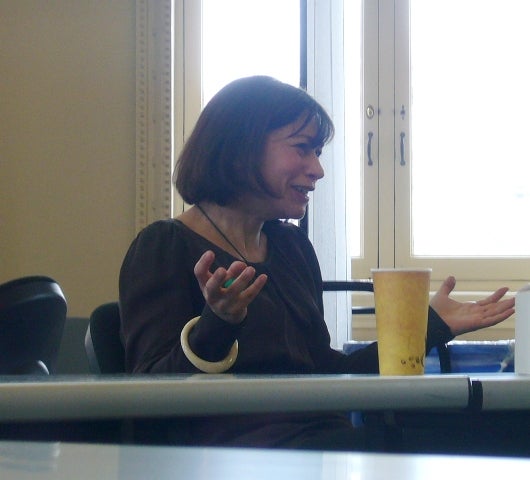A view of the city by Inga Saffron

Feb. 15
By Matt Golas
For PlanPhilly
Inga Saffron, one of the most influential voices at The Philadelphia Inquirer simply because she critiques the powerbrokers who decide what will be designed, built and demolished in the city’s infrastructure and architectural environment, talked to the Penn Design Real Estate Club Friday about what’s “going up, coming down and going on with development and planning here.”
In a wide-ranging Q&A with about 40 planning and design students and professors, Saffron discussed a number of political, infrastructure and development issues, including:
• After a 15-year hiatus in new office development prior to the construction of the Cira Centre, how Philadelphia has had to re-learn and get accustomed again to growing a new built environment. That means coming to grips with the idea that all development is not good development.
• In light of her critical review of the Symphony House condominium, the sometimes challenging role a design critic plays at a major metropolitan newspaper that depends on real estate advertising for its revenue base.
• How civic engagement exercises around planning and development visioning and projects is a good idea, as long as it doesn’t empower community groups and special interest organizations to take on the work that should be tasked to government agencies.
• The Nutter administration has the leadership potential to modernize what have been Byzantine city planning functions and make Philadelphia more consumer friendly.
• That waterfront casinos will adversely affect the whole tone of development around them, especially if casinos with table games, which require a lot more hospitality infrastructure than slots, eventually come to Pennsylvania.
• The Barnes Museum move to the Benjamin Franklin Parkway – as well as projects such as Independence Mall, the National Jewish Museum, Please Touch Museum, and Frank Gehry’s work at the Art Museum – will make Philadelphia more pedestrian friendly.
• Why fixing the parking and traffic problems in center city may ultimately depend on people being more inclined to make SEPTA and mass transit their transportation method of choice.
Saffron, who started her career in The Inquirer’s South Jersey bureau in 1985 covering everything from municipal government to real estate transactions, became the architecture critic for the paper in 1995. She said her diverse assignments here and overseas prepared her for this rare beat (there are only 20 such critics in the country).
“Actually I consider my journalistic career as good preparation for the job,” Saffron said. “About nine years as a local reporter in New Jersey, covering countless planning board, town council and sewer authority meetings. Eight years as a student and then foreign correspondent in Dublin, Paris, Belgrade and Moscow. Covering two immensely destructive wars and seeing a lot of beautiful, historic structures blown to bits. Having seen a bit of the world gives me perspective for evaluating what happens in Philadelphia.”
Speaking of that, on the same day that Saffron spoke to the Penn students her column in The Inquirer strongly suggested that the city’s political and planning leadership come together as one and “see the light” before creating a new $54 million South Street Bridge that right now is more “about moving cars efficiently” than “forging a gracious, urban-scaled link between two vital neighborhoods, Center City and University City.” Read her column here.
Contact the reporter at mgolas@design.upenn.edu
WHYY is your source for fact-based, in-depth journalism and information. As a nonprofit organization, we rely on financial support from readers like you. Please give today.



